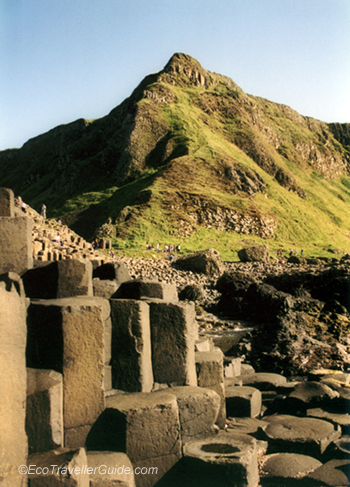Like great grey fingers reaching for the sky, the basalt columns of The Organ at the Giant’s Causeway held me totally captivated as a child. I would stand as close to the columns as possible, lean my head back and stare skyward up along the length of hexagonal stones stacked neatly, one upon the other.
The innocent belief that only a giant could have played this stone organ, or walked along this shore was all-consuming. Any scientific account quickly washed overhead as images of Finn MacCool and Benandonner fighting their corner would play in my head.
Shame we have to grow up.
Still, the science behind the formation of the Giant’s Causeway is as captivating now as the legend once was.
Around 60 million years ago, when the old European and North American tectonic plates were on the move, a volcanic eruption caused lava to come to the surface, which cooled rapidly, hardening into the polygonal basalt columns we see today.
Science buffs can read a more in-depth summary of coastal formation here.
In 1986, the Giant’s Causeway was designated a UNESCO World Heritage Site, and for many years had a small unremarkable visitor’s centre on site until it was destroyed by fire in 2000.
Now, twelve years later, this wonderful World Heritage Site has an undoubtedly more remarkable visitor centre fitting of a natural wonder that draws 600,000 visitors a year.
Designed by Dublin-based architects henehagan peng, the new visitor centre captures the essence of the Giant’s Causeway, with tall basalt columns lining the exterior of the contemporary construction, while inside polished concrete floors and ceilings bring the outside in.
Climb up on to the grass-covered roof, which offers panoramic views of the wind-beaten Antrim coastline.
Added to create more available green space at the centre, the grass roof was one of 10 key sustainable features of the build. The mix of grasses planted on the roof and ramp was grown from seeds collected from surrounding fields to preserve the delicate local ecology.
Other sustainable features of the centre include:
- Permeable paving, the green roof and rainwater harvesting reduce surface water run-off.
- Rainwater and grey water recovery from green roof are used for toilet flushing.
- The building is heated and cooled by the Earth: 4.5km of pipework under the car park utilize geothermal energy for heating, while 1km of pipes in cool earth adjacent to the visitor centre are used for cooling.
- The basalt is locally quarried in Kilrea, from the same lava flows which formed the Causeway, but not from the Causeway area itself as the local rock strata is protected, and concrete with a high recycled content is used.
Inside, a series of interactive exhibits show how the Giant’s Causeway was made, referring to the scientific background as well as the myth behind it, and local beliefs. Mobile handsets can be carried around the centre and coast so you can listen to the history as you walk around, allowing yourself to get lost in this legendary landscape.
If you have a penchant for architecture, like myself, you might be interested in thinking behind the building’s design. Here is the architect’s description of the new centre from their press release:
The site for the visitor centre at the Giant’s Causeway is located below the ridgeline on the landward side of the cliff. By utilising the large difference in level across the site, two folds are created in the landscape. One, extending the line of the ridge, accommodates the building. The second, extending the level of the road, accommodates the car park screening it from view.
The two folds create strong lines in the landscaping, drawing all the man-made interventions together and organising the disparate requirements of the visitor centre into a singular intervention in the landscape. There is no longer a building and landscape but building becomes landscape and the landscape itself remains spectacular and iconic.
The lines that create the folds are made from a series of stacked basalt columns quarried locally Kilrea, from the same lava flows which formed the Causeway (not from the Causeway area itself as the local rock strata is protected).
For information regarding entrance fees and opening times, check out the National Trust website.
- With thanks to henegan peng architects for allowing use of their images.









Pingback: Insider Tips on Things to Do in Northern Ireland
Pingback: 2/52 :: The Dark Hedges